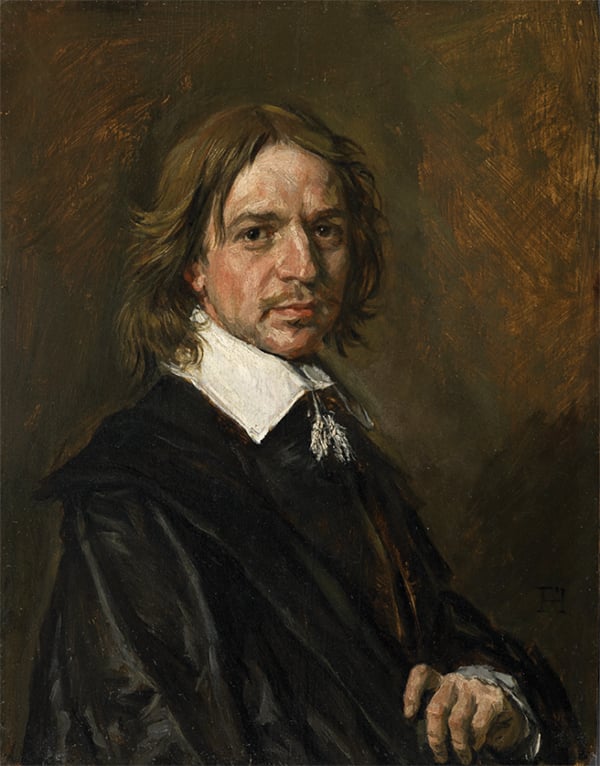
The apparently-fake Frans Hals currently at the center of the art world’s unfolding Old Master forgery scandal may have fooled the experts, but Christie’s Paris had “doubts” about the canvas and actually declined to sell it.
Christie’s communications director Belinda Bowring confirmed these “doubts” in a phone conversation with artnet News, noting that “it did come into us, but we in the end passed on it” because they weren’t satisfied with the provenance and attribution.
When Sotheby’s sold the painting for $10 million in a 2011 private sale, the canvas had been vetted by France’s Center for Research and Restoration as an authentic Old Master. The French government had called the previously-undiscovered work “un trésor national” and banned its export to the UK, giving the Louvre the opportunity to purchase it for €5 million ($7.25 million).
Giuliano Ruffini, left, with Andrée Borie, whose father Andrée, is said to have collected the suspected Old Master forgeries. Courtesy of Giuliano Ruffini.
Previous reports indicated that the Louvre was ultimately unable to raise the money to acquire the work because of the 2008 financial crisis. We now know that when Christie’s Paris was unable to transfer the work to its larger London office for a more thorough vetting due to the export ban, the auction house decided it wasn’t comfortable selling the work.
“As is Christie’s policy, we entered into a contract that allowed us to carry out research on the painting in question,” wrote Bowring in a statement emailed to artnet News. “When we could not satisfy ourselves in terms of provenance and attribution we withdrew from the process and had no further involvement with the work.”
The painting came from French art collector Giuliano Ruffini, a mysterious figure linked to a number of previously-unknown Old Master works that have been discovered in recent years. His collection first fell under suspicion in March, when a Lucas Cranach the Elder Venus belonging to the Prince of Lichtenstein that had come from Ruffini was seized by French authorities under suspicion of forgery.
Sotheby’s responded to that news by having Orion Analytical, the Williamstown, Massachusetts-based company that proved that the Knoedler paintings were fake, analyze the so-called Hals. Synthetic, 20th-century materials were detected, causing Sotheby’s to declare the canvas a fake and issue a refund.
There are those who remain unconvinced by the findings of Orion founder James Martin. Dutch old masters restorer Martin Bijl, who has conserved 30 Hals canvases since 2009, told the New York Times he had examined Orion’s data and still had questions about the work’s authorship.
“The ones who have researched it until now are good researchers, but they’re not familiar with the handwriting of Frans Hals,” he insisted. “That’s an extra reason to be careful.” In an email to artnet News, Bijl also noted that “some important parts of the painting show aging that is not easily to be understand in a new painting.”
Orion’s findings, however were peer-reviewed by a second, independent conservation scientist. The company is currently conducting a full battery of tests on a Saint Jerome originally thought to be by Parmigianino or one of his associates that also originated with Ruffini. The canvas sold for $842,500 at Sotheby’s in January 2012.
Parmigianino, Saint Jerome, now thought to be a forgery. Courtesy of Sotheby’s.
According to the Times, Ruffini brought his Hals, purportedly purchased from a Spanish dealer, to Christie’s Paris in 2008, claiming it might be from the school of Hals or by one of the artist’s followers. Ruffini and his lawyer claim it was the auction house experts who first attributed the work to the master himself.
Bijl believes that additional research could yield provenance information about the painting’s murky pre-Ruffini history, even though it had never been publicly exhibited or mentioned in any scholarly writing about the artists.
“It is not an uncommon phenomenon that Old Master paintings are not listed in the existing literature,” Blaise Ducos, the Louvre’s curator of Dutch and Flemish paintings, told the Times in an email. “One should not forget that the first serious oeuvre catalogs were only made in the 19th century.”
Ducos, who called the work “a very important addition to Hals’s oeuvre” in a 2014 Burlington Magazine article, is unwilling to give up hope. Nevertheless, Christie’s decision to distance itself from the painting years before the recent revelations is another black mark against the Ruffini works, in what is increasingly looking like a major, Knoedler-level scandal.